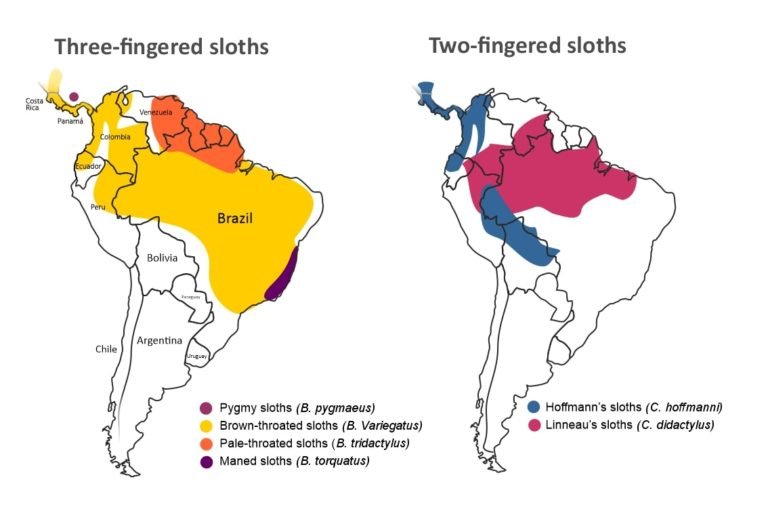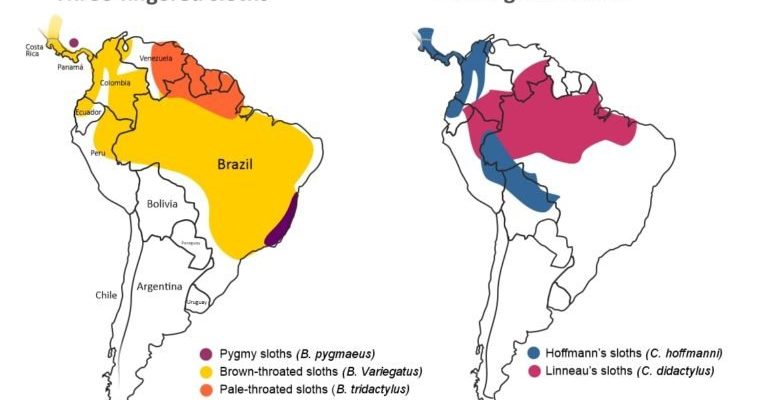
So, where exactly do sloths hang their hats? You might be surprised to learn that they primarily call the tropical rainforests of Central and South America their home. But there’s so much more to their habitat than just trees and leaves. Let’s dive into the world of sloths and explore their natural habitats, distribution, and the challenges they face in the wild.
Understanding Sloths’ Habitat
When we talk about sloth habitats, think of lush, green jungles that are warm and humid all year round. Sloths thrive in these environments, which offer plenty of leaves—their primary food source. There are two main types of sloths: the two-toed and three-toed sloths. Each has its specific preferences, but they generally prefer evergreen and deciduous forests where they can easily blend into the trees.
Sloths spend most of their lives hanging upside down in the branches, and their long claws help them grip onto the tree limbs. They rely on the cover of the trees for protection from predators like jaguars and eagles. Imagine living in a tree where you can sleep for up to 20 hours a day—sounds perfect, right?
Where in the World Are Sloths Found?
Sloths are mostly found in the tropical rainforests stretching from southern Mexico down to Brazil. You’ll also find them in parts of Central America, including countries like Costa Rica and Panama. Specifically, you might see them in:
- Amazon Rainforest
- Atlantic Forest in Brazil
- Central American jungles
- Cloud forests in Colombia and Ecuador
These locations are rich in biodiversity, meaning sloths aren’t the only cool creatures residing there. This abundance of flora and fauna creates a unique ecosystem where sloths can live comfortably.
The Different Species of Sloths and Their Preferences
As mentioned earlier, there are two main types of sloths: two-toed and three-toed. The two-toed sloths tend to prefer the tropical rainforests of Central America, while three-toed sloths are more commonly found in the North. Each species has its unique needs when it comes to habitat.
The two-toed sloth can be found from Honduras down to Brazil, usually hanging around in the treetops of lowland and tropical rainforests. They have a slightly different diet, often munching on a variety of leaves and fruits.
On the other hand, the three-toed sloth lives mainly in the forests of South America, particularly in countries like Bolivia and Brazil. They are more adaptable and can sometimes be found in cloud forests, where the weather is a bit cooler and moister.
Why Are Rainforests Important for Sloths?
Rainforests do more than just house sloths; they also play a crucial role in maintaining our planet’s health. These ecosystems help regulate the climate by absorbing carbon dioxide and producing oxygen. For sloths, their rainforest habitats are packed with everything they need, including:
- Food sources like leaves, fruits, and flowers
- Protection from predators
- A suitable climate that keeps them warm
Without these forests, sloths wouldn’t just be losing their homes; it would also impact their survival as a species. The loss of habitat leads to more sloths becoming vulnerable, which is why conservation efforts are crucial to their future.
Threats to Sloths and Their Habitats
Sadly, sloths face several challenges that threaten their homes and existence. Deforestation is perhaps the most significant issue. As humans expand agriculture and urban areas, vast tracts of forests are cut down. This not only destroys sloths’ habitats but also limits their food sources.
Other threats include:
- Climate Change: Changes in temperature and rainfall patterns can disrupt their habitat.
- Poaching: Illegal hunting poses a threat, although it’s less common.
- Road Traffic: Increasing roadways in forest areas lead to more sloth fatalities.
Conservation groups are working hard to address these issues, but it’s essential for everyone to understand the importance of protecting sloths and their habitats.
Conservation Efforts for Sloths
Fortunately, many organizations are focused on protecting sloths and their environments. These groups often work in the places where sloths live, like the Amazon Rainforest. Their efforts include:
- Preservation of natural habitats: Creating protected areas where sloths can thrive without the threat of deforestation.
- Education: Teaching local communities about the importance of sloths and how to coexist peacefully with them.
- Rehabilitation: Helping injured or orphaned sloths to get back into their natural habitats.
It’s inspiring to see how dedicated people are to saving these lovable creatures. When we all play a part, whether through awareness or support, we can help ensure that sloths continue their slow, charming lives in the trees.
Final Thoughts on Sloths and Their Homes
Sloths are truly special animals, typically found in the vibrant, lush rainforests of Central and South America. Their unique lifestyles and habitats are worth protecting. By understanding where sloths live and the challenges they face, we can better appreciate their place in our world.
So next time you hear about sloths or see them in a documentary, remember: they’re not just slow movers; they’re vital parts of their ecosystems, hanging out in the treetops, relying on forests to survive. Protecting their habitats means not just saving sloths, but also our precious rainforests, which play a vital role in the global environment. Let’s all pitch in to make sure they keep living their slow and steady lives among the branches!

